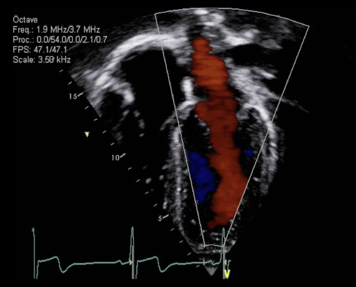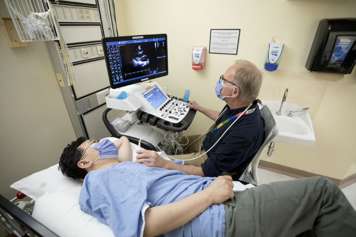什麼是超聲心動圖?

超聲心動圖(或簡稱「超聲」)是一種心臟超聲檢測方法,運用放置在皮膚表面的特殊超聲攝影器,並將聲波發射到體內。該等聲波在碰到身體結構後會反射(或迴響)回攝影器,讓醫護團隊能觀察和評估孩子的心臟。
超聲心動圖檢測前的準備
大多數孩子毋需為接受超聲心動圖檢測而作特別的準備。可是,如果孩子不足 3 歲或不能靜臥,則他們或會需要使用鎮靜劑。鎮靜劑是一種藥物,有助孩子在睡眠中完成檢測。當孩子身體不動時,超聲心動圖的效果最佳。
無需鎮靜劑
如果孩子不需要鎮靜劑,則可在超聲檢測前後正常飲食。如果孩子有喜愛的玩具或安撫毯,請隨身攜帶。每間超聲檢測室都配備一台電視,孩子可以觀看電視以打發時間。
太小的嬰兒不能使用鎮靜劑,其中包括早產或體重較輕的嬰兒。如果您的孩子屬於此類情況,請諮詢醫生或護士,以了解合適的選擇。
如果孩子需要鎮靜劑以進行超聲心動圖檢測
孩子需要在檢測期間保持靜臥,以確保檢測結果準確。如果孩子需要使用鎮靜劑,則臨床護士會給孩子服藥。這種藥物有助孩子在睡眠中完成檢測。藥效持續時間僅足以完成檢測。護士會在鎮靜期間全程監察孩子。
如要使用鎮靜劑,則孩子必須在檢測前數小時停止飲食。護士會在檢測前一週來電,以確保您了解整個檢測過程。下表描述了孩子何時可以進食和飲用什麼。
| 檢測前 | 須知 |
|---|---|
| 8 小時 | 不再進食固體食物,或飲用牛奶或橙汁。這亦意味着不能食用口香糖或糖果。 孩子可飲用清流質。清流質是可透視的清澈液體,如:蘋果汁、薑汁汽水或水。 孩子亦可以食用果凍或冰棒。 |
| 6 小時 | 不再飲用牛奶或配方奶。 |
| 4 小時 | 停止母乳餵哺嬰兒。 |
| 2 小時 | 不再飲用清流質。這意味着不可以再飲用蘋果汁、薑汁汽水或水。孩子亦不能食用果凍或冰棒。 |
有關鎮靜劑的詳情,請瀏覽鎮靜頁面,或諮詢醫生或護士。
全身麻醉以進行超聲心動圖檢測
如果孩子大於 3 歲但不能靜臥,則或會需要 全身麻醉。孩子會在醫院的另一個區域就診,在該處麻醉師會施用麻醉藥,並在麻醉期間全程監察孩子。超聲檢測儀會被帶到孩子接受麻醉的地方。護士會在檢測前一週來電,以確保您了解如何為檢測和麻醉作好準備。
透過角色扮演與孩子模擬檢測過程
您和孩子可在家中模擬檢測過程。
將燈光調暗,讓孩子仰臥。告訴他們室內會很溫暖且非常安靜,因為超聲師必須全神貫注地進行檢測。告訴孩子,超聲師會在其胸部貼上三個小貼片。在孩子胸部正中和左側塗上一些溫熱的護手霜。用光滑的玻璃杯底部在胸部推開護手霜,並解釋說玻璃杯就像超聲師用來拍照的攝影器。帶上孩子最愛的玩具或安撫毯。告訴孩子必須脫掉襯衫或毛衣,然後穿上超聲實驗室提供的衣服。告訴孩子,您可以按他們意願,在檢測期間躺在超聲床上,躺在他們身旁。確保孩子知道檢測需要一段時間,但您會一直陪伴。
協助孩子為超聲心動圖檢測作好準備
誠實且坦率地告訴孩子將會發生什麼。耐心解釋超聲心動圖檢測的過程是怎樣。以切合孩子理解水平的方式,儘量詳細解釋。提前告訴他們檢測時間,這樣他們便不會對要到醫院感到驚訝。告訴孩子,您會在檢測期間一直陪伴。
以下影片可用於協助孩子為超聲心動圖、血管超聲波或單車負荷超聲檢測作好準備。
超聲心動圖檢測的過程

檢測師受過進行超聲心動圖檢查的專門培訓。他們被稱為心臟超聲師。
超聲師會首先量度孩子的身高和體重。隨後,他們會將您和孩子帶到超聲檢測室。
孩子要將腰部以上的毛衣、襯衫和其他衣物更換為超聲師所提供的長袍。超聲室設有私人的更衣區。
孩子會躺在一張可上下移動的床上。超聲師會在孩子的胸部或手臂貼上三個貼片。這些貼片稱為電極,由電線連接至超聲檢測儀,並在檢測期間記錄孩子的心跳。
接下來,超聲師會在孩子的胸部和腹部塗上一些溫熱的超聲波凝膠,以便超聲波攝影器能輕易地在孩子的皮膚上移動。超聲師會從不同角度拍攝孩子的心臟照片。孩子或會在攝影器的所在位置和移動期間感到輕微的按壓感。攝影器會從胃部、胸部和頸部拍攝照片。在檢測過程中,或會要求孩子以不同的姿勢躺着:仰臥、側臥、仰臥時仰頭。有時,當超聲檢測儀記錄心臟的血流時,孩子或會聽到響亮的嗖嗖聲。

室內燈光會調暗,以便超聲師能看清電腦屏幕上的圖片。
超聲師會在完成拍攝後製作報告,並向心臟科醫生展示圖片。此時,心臟科醫生或會選擇拍攝更多照片。這是檢測的正常步驟。在此期間,孩子會與超聲檢測儀保持連接。超聲師或護士會通知您孩子何時可以換回自己的衣服。
超聲心動圖檢測需時 30 分鐘至 90 分鐘或以上。通常,孩子第一次做超聲心動圖檢測會需時較久。檢測所需的時間亦取決於醫生要求孩子進行檢測的原因。
其他類型的超聲心動圖
什麼是胎兒超聲心動圖?
當嬰兒仍在母親子宮內時所進行的超聲心動圖檢測,稱為胎兒超聲心動圖。超聲心動圖檢測可以在懷孕 16 週時檢測到畸胎,此時胎兒的心臟已清晰可見。如有先天性心臟病家族史、懷疑染色體異常、心率不整,或母親患有可能會影響胎兒心臟發育的疾病,則通常會進行胎兒超聲心動圖檢測。
在進行此檢測時,會在孕婦胃部塗上超聲波凝膠,這有助傳送聲波並獲取高質素的照片。進行此檢測前通常不需喝水。
詳情請瀏覽 胎兒心臟計劃網站。
什麼是運動負荷超聲心動圖?
此超聲心動圖檢測是在孩子騎行一種特殊的單車時進行。心臟圖片會在孩子開始騎單車前、騎行中,以及運動後採集。在整個檢測過程中,亦會監測孩子的血壓和心電活動。
這項檢測用於研究在非靜止狀態下,心肌收縮以及血液流經心瓣和冠狀動脈的情況。此檢測通常用於了解運動對心臟的影響,以及運動後心臟恢復的速度。
什麼是多巴酚丁胺負荷超聲心動圖?
多巴酚丁胺負荷超聲心動圖是一種負荷超聲心動圖檢測的形式,在經靜脈注射名為多巴酚丁胺的藥物(含或不含鎮靜劑)後進行。多巴酚丁胺是一種可加速心臟搏動的藥物,其對心臟的作用與運動相似。多巴酚丁胺不會長時間留在體內,亦沒有持久的影響。如果不使用鎮靜劑,孩子在檢測期間或會感到焦慮,因為他們會感到心跳像在運動時般加快,且其感知溫度亦或會上升。進行此檢測方法的原因與運動負荷超聲心動圖相似,但可用於無法進行運動以接受檢測的兒童。
什麼是氣泡測試?
如有需要,在進行超聲心動圖檢測期間,會將一種稱為造影劑的液體注入孩子的血液中。這有助獲取更清晰的超聲心動圖影像。其中一種造影劑是混合氣體的鹽水(無菌鹽水)。通常採用二氧化碳氣體,亦即令梳打水起泡的同一種氣體。若運用此檢測方法,即稱為氣泡測試。
氣泡測試可讓心臟科醫生觀察氣泡通過血流的路徑。這有助發現心臟或肺部問題。氣泡測試對人體無害,且氣泡溶液很容易被孩子的血液吸收。
什麼是經食道超聲心動圖 (TEE)?
經食道超聲心動圖 (TEE) 是透過將特殊探頭放入喉嚨並伸入食道所進行的超聲心動圖檢測。探頭是一根幼長軟管,末端帶有一個微型攝影器。檢測期間,孩子會接受全身麻醉。
經食道超聲心動圖可拍攝比常規超聲更清晰的圖片,因為探頭能更接近心臟。如果常規超聲心動圖的圖片不夠清晰,則會在手術結束前,在手術室內,以及有時在心導管插入術期間進行 TEE。
獲取超聲心動圖檢測結果
只有孩子的心臟科醫生、普通科醫生或其他要求檢測的專科醫生,才能為您提供孩子的超聲心動圖檢測結果。
進行檢測的超聲師或審閱圖片的心臟科醫生皆不得向您提供檢測結果。這一點很重要,因為他們並不了解您和您孩子的所有健康狀況。
在 SickKids
此檢測通常在醫院 Atrium 4B 的 Labatt 家庭心臟中心 (Labatt Family Heart Centre) 的超聲心動圖實驗室 (超聲室) 進行。使用鎮靜劑的超聲心動圖檢測通常在 Burton Wing 的心導管實驗室 (Cardiac Catheterization Lab) 進行。我們亦為全院病人提供床邊超聲心動圖檢測服務。
超聲室內亦設有 胎兒心臟計劃以及研究實驗室。如欲了解更多的研究資訊,或者如果您或您認識的人有興趣參與心血管研究,請瀏覽 心血管超聲研究實驗室 (Cardiovascular Ultrasound Research Lab) 網站。